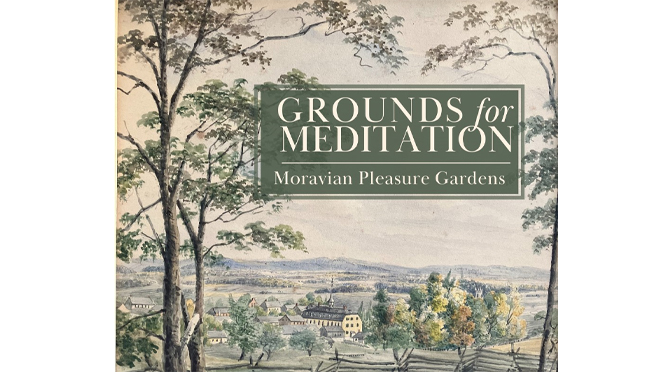|
|
Sara Cedar Miller, historian emeritus of the Central Park Conservatory, will speak about Moravian Pleasure Gardens and their influence on American Parks.
Nazareth, PA—The Moravian Historical Society announces the opening of a new special exhibition, Grounds for Meditation: Moravian Pleasure Gardens, on Sunday, March 10, 2024.
Grounds for Meditation: Moravian Pleasure Gardens explores the international influences which the Moravians brought together to create their own distinct landscapes and pleasure gardens in Europe and Pennsylvania. In the mid-18th to early 19th centuries, an era when Moravians lived and worked communally, these green spaces provided a place for rest, contemplation of nature, and mental solitude. Through collected reminiscences and first-hand observations made by visitors to these early American parks, this special exhibition explores varied historic landscapes that are no longer possible to see and experience.
The inspiration for the exhibition began when curator Farrar Lannon was struck by the beautiful landscapes in the Moravian Historical Society collection of the Bethlehem and Nazareth settlements and pleasure gardens. She realized that these Moravian gardens predated many other public parks in America, illustrating the Moravians’ commitment to nature. “As the landscape surrounding Nazareth continues to change, with mushrooming distribution centers near Route 33, I wanted to highlight the beauty of this area and the need for preservation,” says Lannon.
The public is invited to attend a talk by Sara Cedar Miller, historian emerita of the Central Park Conservatory, at 1:00 pm in the Museum. Miller will place the Moravian pleasure gardens in the context of American parks, from the first public commons to the most iconic urban parks.
Moravian pleasure gardens pre-date the creation of Central Park by over a century, yet the purpose of these green spaces was similar. This illustrated talk, “A Rest from Mental Toil: Central Park and Moravian Pleasure Gardens,” will examine the history and design of New York’s celebrated Park and how its landscapes relate to the pleasure gardens built by Moravians.
Miller has been the historian emerita of the Central Park Conservancy since 2017. She was the Conservancy photographer from 1984 and also its historian from 1989 to 2017. Miller is the author of Central Park: An American Masterpiece (2003), Strawberry Fields, Central Park’s Memorial to John Lennon (2011), Seeing Central Park: The Official Guidebook: Updated and Expanded (2021) and Before Central Park (2022).
Seating in the Museum is limited and advanced reservations are required. Tickets for the talk are
$12 ($6 for MHS members and free for students with ID) and can be purchased by visiting www.moravianhistory.org/music-and-lectures.
Following the talk, the public is invited to a free opening reception for the special exhibition from 2:00 to 4:00 pm.
Grounds for Meditation: Moravian Pleasure Gardens will be on view from March 10, 2024, through February 16, 2025. The talk and exhibition are supported, in part, by the County of Northampton Hotel Tax Grant Program.
Founded in 1857, the Moravian Historical Society (MHS) preserves, interprets, and celebrates the rich culture of the Moravians. MHS maintains the 1740–1743 Whitefield House and the 1740 Gray Cottage, the oldest surviving Moravian structure in North America. Recognized widely for its significant collection, the museum offers permanent and changing exhibitions, educational programs, guided tours, and public activities. Highlights of the collection include a significant collection of early musical instruments, many of which represent the first of their kind made in America, including the 1759 Antes violin, the c. 1745–1765 upright piano, and the 1761 Tannenberg clavichord.
The Moravian Historical Society’s Museum is open daily from 1:00 to 4:00 pm and is located at 214 East Center Street, Nazareth, Pennsylvania.
For more information, visit www.moravianhistory.org
Follow us on social media:
Facebook: moravianhistoricalsociety | Instagram: moravianhistory
Information provided to TVL by:
Moravian Historical Society
https://www.moravianhistory.org/







